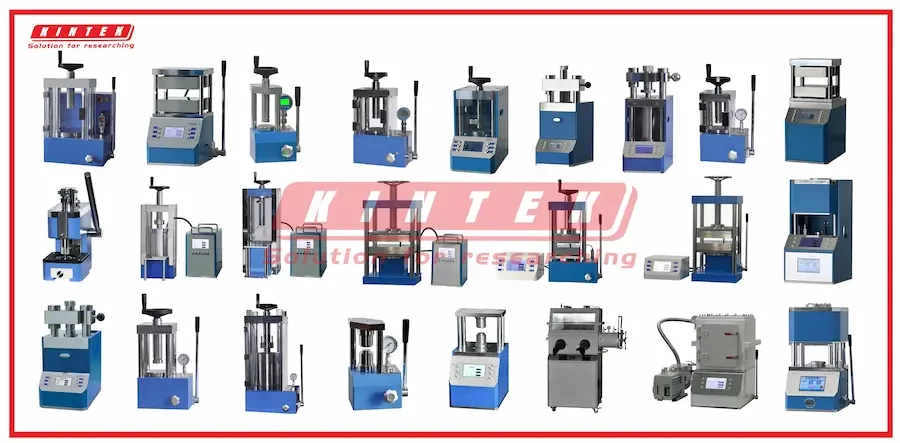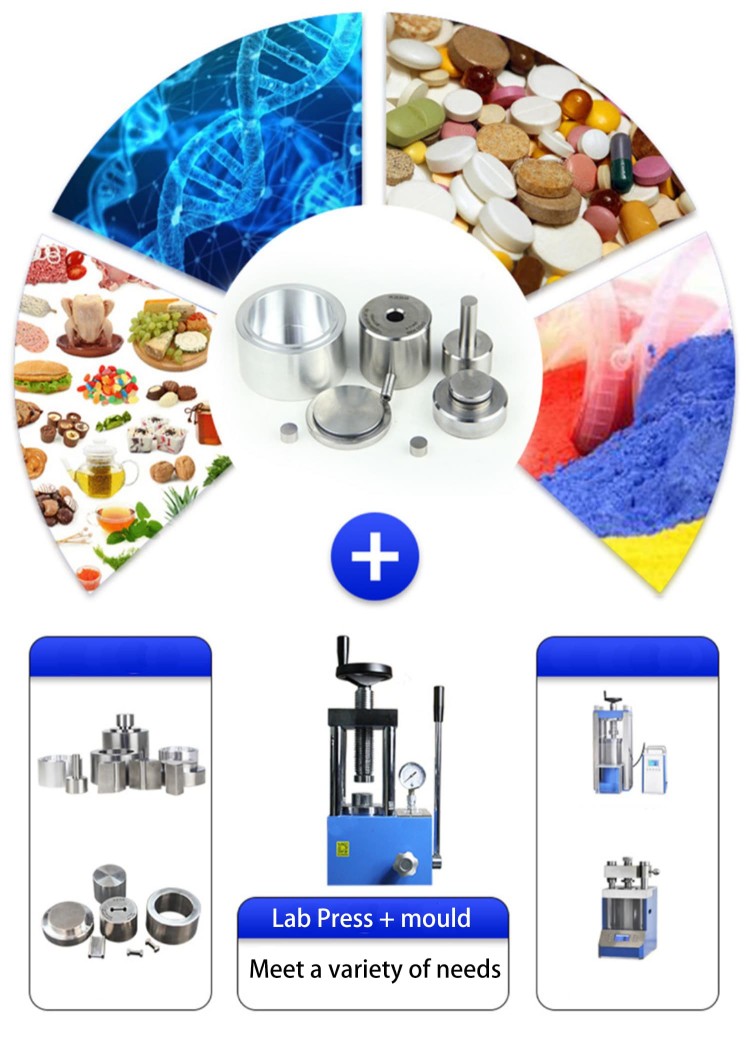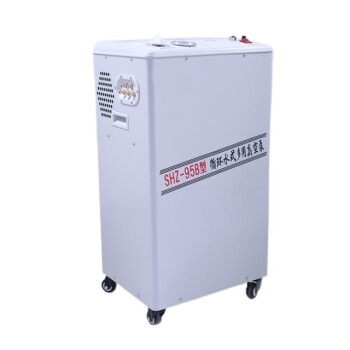
Manual Lab Press
kbr pellet press 2t
Item Number : PCKBR
Price varies based on specs and customizations
- Working pressure
- 0-2 T
- Piston diameter
- 28 mm
- Piston stroke
- 5 mm
- Weight
- 4.8 kg
Shipping:
Contact us to get shipping details Enjoy On-time Dispatch Guarantee.
Why Choose Us
Easy ordering process, quality products, and dedicated support for your business success.
Introducing
Introducing the KINTEK KBR Press - a handheld laboratory hydraulic press designed for entry-level users. Its primary function is to prepare high-quality KBr pellets essential for transmission FTIR analysis, utilizing pressure of up to 2 tons. The press is available for purchase either on its own or as part of a complete kit. Engineered with durability in mind, this compact hydraulic press is built to withstand regular use in the laboratory, offering maintenance-free operation. Additionally, its portability enhances its versatility, making it an ideal choice for those on the move.
Advantages
- The upper plate adopts electroplated countersunk head hexagonal screws, beautiful and space-saving
- Chrome-plated cylinder, smooth surface, no rust, good sealing rubber ring, no oil leakage
- One-piece main board structure, oil pool, main board, oil cylinder in a body, no seal connection
- All aluminum alloy hand wheel, beautiful, practical, not easy to break
- Small size, light weight, no oil leakage, can be used in the glove box
- Mold using Japanese high-speed steel, good material, high hardness, no deformation, long service life
- Digital display pressure gauge, more accurate pressure control, pressure display accuracy of 0.01MPa
- Oil pool outside the host, easy to replace the oil, and the oil circuit increased the hydraulic oil filtration device
- Special plunger, using special custom sealing structure, excellent sealing effect
Technical specifications
| Model | PCKBR-2T |
|---|---|
| Working pressure(T) | 0-2(20Mpa) |
| Piston diameter | ≤1MPa/10min |
| Workbench diameter | Φ45mm(D) |
| Number of columns | Two |
| Working space | 54×55 (M×N) |
| Dimensions | 100×220×220(W×L×H) |
| Weight(kg) | 4.8kg |

- Volume: The tablet press is small in size, light in weight, does not leak oil, and is easy to carry and can be used in the glove box.
- Structure: Simple structure, no one-way valve, more stable upper pressure, suitable for use with infrared spectrometers.
- Operation: The operation is simple. Tighten it by hand to apply pressure, and loosen it to release pressure.
Operation
Please click the link for detailed steps
Before we dive into the step-by-step instructions, it's essential to note that safety is of utmost importance when operating the Manual lab press machine. Always wear protective gloves and eye goggles when handling the machine, and make sure to read the user manual carefully before use.

Preparation and Assembly: Begin by assembling the KBR mold according to the guidelines. Ensure that the samples to be pressed are properly positioned within the mold.

Insertion and Fixation: Gently place the assembled KBR mold into the designated area within the KBR press. With care, tighten the screws provided to secure the mold in place.

Adjustment and Pressurization: Turn the handle in a clockwise direction to apply pressure to the mold. Gradually increase the pressure to the desired level for your specific requirements. It's recommended to do this in a controlled and steady manner.

Maintain Pressure: Once the desired pressure is achieved, maintain this pressure consistently for the designated duration. The duration may vary depending on the nature of your samples and the desired outcome.

Release and Extraction: When the pressing duration is completed, carefully release the pressure by turning the handle counterclockwise. Ensure that the release is gradual to prevent any sudden shifts that might damage the samples or the press.

Disassembly and Sample Retrieval: Gently disassemble the KBR mold, taking care not to disturb the pressed samples. Retrieve the pressed samples with meticulous attention to detail, preserving their integrity for subsequent analyses or studies.
Full range of lab press types

Click to view our full range of lab press products.
Any question? Our experts have helped many laboratories choose their lab press, contact us now!
Full range of types of laboratory press molds
We have a full range of molds for you to choose from, and the molds fit the body perfectly.
If you need molds with special shapes, we can also customize them for you.

Warnings
Operator safety is the top important issue! Please operate the equipment with cautions. Working with inflammable& explosive or toxic gases is very dangerous, operators must take all necessary precautions before starting the equipment. Working with positive pressure inside the reactors or chambers is dangerous, operator must fellow the safety procedures strictly. Extra caution must also be taken when operating with air-reactive materials, especially under vacuum. A leak can draw air into the apparatus and cause a violent reaction to occur.
Designed for You
KinTek provide deep custom made service and equipment to worldwide customers, our specialized teamwork and rich experienced engineers are capable to undertake the custom tailoring hardware and software equipment requirements, and help our customer to build up the exclusive and personalized equipment and solution!
Would you please drop your ideas to us, our engineers are ready for you now!
FAQ
What Are Laboratory Hydraulic Machines?
What Is A Lab Press?
What Is An FTIR Press Used For?
What Are The Advantages Of Using Laboratory Hydraulic Machines?
What Are The Applications Of Pellet Presses?
What Is The Purpose Of A Hydraulic Press In Lab?
What Types Of FTIR Presses Are Available?
How Do Electric Laboratory Presses Work?
What Is KBr Used For?
What Are The Applications Of Laboratory Hydraulic Machines?
How Does A Pellet Press Work?
What Are Different Type Of Lab Presses?
How Does An FTIR Press Work?
How Do You Prepare Pressed Pellets For XRF?
What Are The Advantages Of Using Electric Laboratory Presses?
What Is The KBr Pellet Method?
What Are The Main Components Of A Laboratory Hydraulic Machine?
What Are The Benefits Of Using A Pellet Press?
What Are The Advantages Of Using An FTIR Press?
What Pressure Should XRF Pellets Be?
What Are The Applications Of Electric Laboratory Presses?
Why KBr Is Used For Pellet?
What Considerations Should Be Taken When Selecting A Laboratory Hydraulic Machine?
What Factors Should Be Considered When Selecting A Pellet Press?
What Materials Can Be Used With An FTIR Press?
What Is The Advantage Of XRF Pressed Pellet Technique?
What Considerations Should Be Taken When Selecting An Electric Laboratory Press?
How To Make KBr Pellets For FTIR?
4.9 / 5
The KBr Pellet Press 2T is a game-changer for our lab. It's compact, easy to use, and delivers consistent results.
4.8 / 5
The KBr Pellet Press 2T has significantly improved our sample preparation process. It's reliable, efficient, and produces high-quality pellets.
4.7 / 5
The KBr Pellet Press 2T is an excellent piece of equipment. It's well-built, durable, and makes preparing KBr pellets a breeze.
4.6 / 5
The KBr Pellet Press 2T is a valuable addition to our lab. It's easy to operate, produces consistent results, and saves us time.
4.8 / 5
The KBr Pellet Press 2T is a great investment. It's affordable, easy to maintain, and has helped us improve the quality of our analyses.
4.7 / 5
The KBr Pellet Press 2T is a versatile tool. It's suitable for various applications and produces high-quality pellets every time.
4.9 / 5
The KBr Pellet Press 2T is a lifesaver. It's easy to use, produces reliable results, and has significantly improved our productivity.
4.6 / 5
The KBr Pellet Press 2T is a well-designed instrument. It's compact, portable, and produces high-quality pellets with minimal effort.
REQUEST A QUOTE
Our professional team will reply to you within one business day. Please feel free to contact us!
Related Products

Automatic Laboratory Hydraulic Pellet Press Machine for Lab Use
Experience efficient sample preparation with our Automatic Lab Press Machine. Ideal for material research, pharmacy, ceramics, and more. Features a compact size and hydraulic press functionality with heating plates. Available in various sizes.

Automatic Laboratory Hydraulic Press for XRF & KBR Pellet Press
Fast and easy xrf sample pellet preparation with KinTek Automatic Lab Pellet Press. Versatile and accurate results for X-ray fluorescence analysis.

Laboratory Manual Hydraulic Pellet Press for Lab Use
Efficient sample preparation with small footprint Manual Lab Hydraulic Press. Ideal for material researching labs, pharmacy, catalytic reaction, and ceramics.

Laboratory Hydraulic Pellet Press for XRF KBR FTIR Lab Applications
Efficiently prepare samples with the Electric Hydraulic Press. Compact and portable, it's perfect for labs and can work in a vacuum environment.

Laboratory Manual Hydraulic Pellet Press for Lab Use
Efficient Manure Lab Hydraulic Press with Safety Cover for sample preparation in material research, pharmacy, and electronic industries. Available in 15T to 60T.

Laboratory Hydraulic Press Lab Pellet Press Machine for Glove Box
Controlled environment lab press machine for glove box. Specialized equipment for material pressing and shaping with high precision digital pressure gauge.

Laboratory Hydraulic Press Split Electric Lab Pellet Press
Efficiently prepare samples with a split electric lab press - available in various sizes and ideal for material research, pharmacy, and ceramics. Enjoy greater versatility and higher pressure with this portable and programmable option.

Laboratory Hydraulic Press Lab Pellet Press for Button Battery
Efficiently prepare samples with our 2T Button Battery Press. Ideal for material research labs and small-scale production. Small footprint, lightweight, and vacuum-compatible.

Manual Heated Hydraulic Press Machine with Heated Plates for Laboratory Hot Press
The Manual Heat Press is a versatile piece of equipment suitable for a variety of applications, operated by a manual hydraulic system that applies controlled pressure and heat to the material placed on the piston.

Automatic Heated Hydraulic Press Machine with Heated Plates for Laboratory Hot Press 25T 30T 50T
Efficiently prepare your samples with our Automatic Heated Lab Press. With a pressure range up to 50T and precise control, it's perfect for various industries.

30T 40T Split Automatic Heated Hydraulic Press Machine with Heated Plates for Laboratory Hot Press
Discover our split automatic heated lab press 30T/40T for precise sample preparation in material research, pharmacy, ceramics, and electronics industries. With a small footprint and heating up to 300°C, it's perfect for processing under vacuum environment.

Automatic Heated Hydraulic Press Machine with Heated Plates for Laboratory Hot Press
The Automatic High Temperature Heat Press is a sophisticated hydraulic hot press designed for efficient temperature control and product quality processing.

Heated Hydraulic Press Machine with Heated Plates Split Manual Laboratory Hot Press
Efficiently prepare your samples with our Split Manual Heated Lab Press. With a pressure range up to 40T and heating plates up to 300°C, it's perfect for various industries.

Electric Heated Hydraulic Vacuum Heat Press for Lab
The Electric Vacuum Heat Press is a specialized heat press equipment that operates in a vacuum environment, utilizing advanced infrared heating and precise temperature control for high quality, rugged and reliable performance.

Heated Hydraulic Press Machine with Heated Plates for Vacuum Box Laboratory Hot Press
Enhance your lab's precision with our lab press for vacuum box. Press pills and powders with ease and precision in a vacuum environment, reducing oxidation and improving consistency. Compact and easy to use with a digital pressure gauge.

Heated Hydraulic Press Machine with Heated Plates for Vacuum Box Laboratory Hot Press
The lab press for vacuum box is a specialized piece of equipment designed for laboratory use. Its main purpose is to press pills and powders according to specific requirements.

Ball Press Mold for Lab
Explore versatile Hydraulic Hot Press molds for precise compression molding. Ideal for creating various shapes and sizes with uniform stability.

Manual Cold Isostatic Pressing Machine CIP Pellet Press
Lab Manual Isostatic Press is a high-efficient equipment for sample preparation widely used in material research, pharmacy, ceramics, and electronic industries. It allows for precision control of the pressing process and can work in a vacuum environment.

Laboratory Vertical Water Circulating Vacuum Pump for Lab Use
Looking for a reliable water circulating vacuum pump for your lab or small-scale industry? Check out our Vertical Water Circulating Vacuum Pump with five taps and a larger air sucking amount, perfect for evaporation, distillation, and more.
Related Articles

The Benchtop KBr Pellet Press: An Efficient Tool for Laboratory Use
The benchtop KBr pellet press is a versatile and efficient tool that produces uniform pellets, ensuring consistent and reliable results. In addition, its adjustable mold can be used flexibly to accommodate a variety of sample sizes and shapes.

An In-Depth Guide on Laboratory Presses and KBr Pellets Production
In the world of scientific research and analysis, laboratory presses and KBr pellet production play a crucial role. These tools are essential in the preparation of samples for various analytical techniques, such as infrared spectroscopy and XRF spectroscopy.

A Comprehensive Guide on Pressing XRF Pellets Using a KinTek Automatic Hydraulic Press
XRF (X-ray fluorescence) analysis is a powerful technique used in various industries for material analysis. One crucial step in the XRF analysis process is the preparation of high-quality XRF pellets. These pellets serve as the sample for analysis and need to be properly pressed to ensure accurate results.

Exploring the Benchtop KBr Pellet Press: Features, Mechanism, and Applications
The benchtop KBr pellet press is a versatile and essential tool in a variety of laboratory settings. Whether you work in pharmaceuticals, biology, nutrition, or spectroscopy, this compact and user-friendly press will simplify your sample preparation process.

Benchtop KBr Pellet Press: A Comprehensive Overview
If you're looking for a way to compress powdered materials into uniform pellets without contamination, then the KBr Pellet Press might just be the perfect solution for you. Whether you're working in a pharmaceutical, biological, nutrition, or spectrographic lab, this hand-operated press offers convenience and efficiency in a small package.

Automated laboratory XRF and KBR pellet press operating procedures
Introduction to automated laboratory XRF and KBR pellet press operating procedures.

Manual Hydraulic Pellet Press: An Efficient Tool for Spectral Analyses Preparation
The manual hydraulic pellet press offers several key features that make it a valuable tool for laboratory applications. Some of the main features include:Availability of pressing tools in different diameters: 40mm, 32mm, and 15mm;Availability of pressing tools in different diameters: 40mm, 32mm, and 15mm;Designed pressure force display in 10 kN steps;Ease of operation via hand lever;Convenience in cleaning;Single-stage piston stroke of maximum 25mm ect.

Comprehensive Guide to Manual Hydraulic Pellet Press
A manual hydraulic pellet press is a valuable tool in the laboratory for preparing pellets with a smooth and homogeneous surface for spectral analyses. It is commonly used in applications such as X-ray fluorescence analysis or infrared spectroscopy for elemental analysis.

Choosing the Right Lab Press: A Comprehensive Guide
When choosing a lab press, it is important to consider the load or force that will be applied to the sample. This will ensure that the press is capable of providing the necessary pressure for your specific application.

How to choose a laboratory hot press
The laboratory hot pressing machine is suitable for laboratory users who are strict about sample pressing temperature, pressure control accuracy and need a wide size mold for pressing samples. The new lab hot press of KINDLE TECH has a double-plate structure and a pressing force of 0~40 tons.

Understanding the Functioning and Applications of a Hydraulic Pellet Press
A hydraulic press is a compression device that makes use of an exerted force placed upon a fluid, to create a resulting force according to Pascal’s Law. It was actually invented by Joseph Bramah, so is also known as the Bramah Press.

FTIR Pellet Press The Ultimate Solution for Precise Sample Preparation
Fourier Transform Infrared (FTIR) spectroscopy is a powerful analytical technique that can be used to identify and quantify the chemical components of a sample. However, to obtain accurate and reliable results, it is crucial to prepare the sample appropriately.